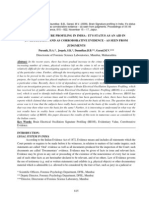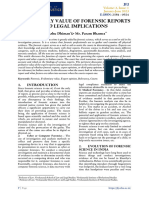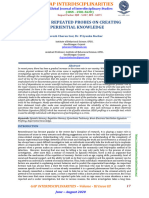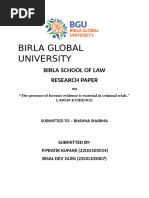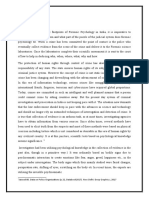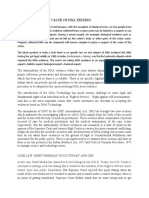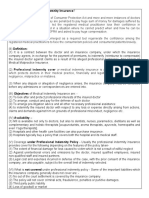Brain Signature Profilling
Brain Signature Profilling
Uploaded by
Sandeep BansalCopyright:
Available Formats
Brain Signature Profilling
Brain Signature Profilling
Uploaded by
Sandeep BansalCopyright
Available Formats
Share this document
Did you find this document useful?
Is this content inappropriate?
Copyright:
Available Formats
Brain Signature Profilling
Brain Signature Profilling
Uploaded by
Sandeep BansalCopyright:
Available Formats
Brain Signature Profiling (BSP) or Brain Electrical Oscillation Signature Profiling (BEOS)
[Based on Gautam Biswas & Anil Aggrawal]
Q) Write a short note on Brain Signature Profiling (BSP) or Brain Electrical Oscillation Signature Profiling (BEOS)?
A) (I) Introduction –
(1) Brain Electrical Oscillation Signature profiling is a technique developed by Dr. C.R. Mukundan in the year 2003.
(2) This technique is currently been used in a Forensic set-up to identify the presence of Experiential Knowledge in the
perpetrator of the crime.
(II) Principle –
(1) Knowing and Remembering are two Neurocognitive processes, of which Knowing refers to the cognitive process of
recognition with or without familiarity, whereas Remembrance is the recall of episodic and autobiographical details from a
person’s life. Differentiation of neurocognitive processes of recognition and remembrance have been established by numerous
studies.
(2) Recognition or Knowledge is a conceptual representation, acquired through various means of communication and
conceptualization. While Remembrance is the neurocognitive process of bringing personal past to the present and thus involves
Personal Experience of an individual which was gained by personal participation.
(3) The program of Brain Electrical Oscillation Signature Profiling does not measure Knowledge but it measures remembrance of
the Experiential Knowledge or autobiographical information, which consists of awareness of internal processing or remembrance,
sensory-motor mental imageries associated with experience.
(4) The electrical activity related to remembrance is called the “Signature” of the experience. The process is defined as the
retrieval of the Experiential Knowledge. The signature will be present only if a remembrance can be evoked by the specially
designed probes. Absence of Experiential Knowledge results in the absence of the signature.
(5) Experiential knowledge is facilitated by awareness of contextual details and emotional arousal if present.
(III) Evidentiary Value of BSP/BEOS –
(1) The technology of BEOS is being currently used in the Forensic Laboratories of Mumbai, Gandhinagar and Chandigarh and
further many more laboratories are planning to start this test.
(2) Currently, approximately 300 subjects have undergone the BEOS test for the cases in which they have been suspected to be
involved and in some of these cases, the Experts have been summoned under Section 45 of Indian Evidence Act.
(3) On the basis of the judgments which have been available, till now no court has objected to the use of this test for the purpose
of the investigation.
(4) Section 45 of the Indian Evidence Act is wide enough to accept results of an expert in any field of science or art, when the
court has to take decision. Hence under this section, courts have been accepting the results of the BEOS test provided they are
being corroborated by other substantive or even circumstantial evidences which together are enough to convict a perpetrator of
the crime.
(5) Court’s opinion in a criminal case – “Since the tests are scientific tests, are conducted in scientific manners and with latest
scientific machines and therefore, these examinations and its results cannot be discarded in this case as it corroborates with
other evidence brought on record by the prosecution including oral as well as documentary and therefore, the results of the said
examinations are acceptable in this case”.
(6) BSP/BEOS has only corroborative value. There has been not even a single case, in which the court has convicted a
subject based only on the results of the BEOS test. In the cases, wherein results of the BEOS tests and other Psychological tests
were Positive but were not supported by other oral or documentary evidences, the subjects in those cases have been acquitted
of the charges against them.
(7) Although, the BEOS test may be used for a particular case, it is not necessary that the reports may get submitted in court.
(IV) BSP/BEOS is not in violation of Article 20(3) of Constitution –
(1) In a criminal case, court opined – “as these tests are not in the nature of Testimonial compulsion, they do not in any way
violate Article 20(3) of Constitution and recourse to such test can be taken if and when investigating agency seeks to introduce
such statement as evidence.” Thus the use of these tests both during the course of investigation and trial is held to be
admissible.
(V) Conclusion –
(1) Brain Electrical Oscillation Signature Profiling (BEOS) is certainly a useful test as an aid to investigation provided it has been
conducted in a scientific manner.
(2) The results of the BEOS test, if positive, and if supported by other direct or circumstantial evidences can be accepted as
corroborative evidence under Section 45 of Indian Evidence Act.
(3) If the result of the test are positive but are not corroborated with other direct or circumstantial evidences, then they are not
substantive enough to convict an individual suspected of the charges of committing the crime.
(4) If the tests of the results are negative, and if they are not supportive of prosecution, the courts may consider that, the purpose
for which the test was taken has not been served.
(5) If the test results are negative, but there is other evidence enough to prove the guilt of the perpetrator, the person would still
get convicted.
(6) Even if the test results are positive, they may not be submitted in court and hence may not even be accepted as evidence.
You might also like
- Acquisition Case Study: This Presentation Is Created byDocument12 pagesAcquisition Case Study: This Presentation Is Created byRifky PakayaNo ratings yet
- Narco AnalysisDocument13 pagesNarco AnalysisShivangi Porwal100% (1)
- Locards Exchange Principle & Its ApplicaitonDocument2 pagesLocards Exchange Principle & Its ApplicaitonSandeep Bansal100% (6)
- Ennegram - Introductory DocumentDocument8 pagesEnnegram - Introductory DocumentJagat RathoreNo ratings yet
- TOR Up LIST Directory - ToR Up LIST Directory - ToR Up LIST Directory - ToR Up LIST Directory - Quick Leak - Join Us and Set Yourself Free!Document354 pagesTOR Up LIST Directory - ToR Up LIST Directory - ToR Up LIST Directory - ToR Up LIST Directory - Quick Leak - Join Us and Set Yourself Free!Juve HernándezNo ratings yet
- Beos in IndiaDocument10 pagesBeos in IndiaN Nanda GaneshNo ratings yet
- BEOS NewDocument5 pagesBEOS Newnandithas175No ratings yet
- Selvi V State of KarnatakaDocument2 pagesSelvi V State of KarnatakaDhriti SharmaNo ratings yet
- Unit 3Document55 pagesUnit 3Midhuna BijuNo ratings yet
- TECH LAW_062_VASUNDHRA.pdfDocument16 pagesTECH LAW_062_VASUNDHRA.pdfRajni PorwalNo ratings yet
- The Polygraph Usage in Romania and Japan InfoDocument7 pagesThe Polygraph Usage in Romania and Japan InfoPop MisaNo ratings yet
- Symbiosis International University: Research Project On Examination of Physical Evidence: A Detailed StudyDocument26 pagesSymbiosis International University: Research Project On Examination of Physical Evidence: A Detailed StudysulagnaNo ratings yet
- NARCO AnalysisDocument13 pagesNARCO Analysisbhuvi29may2002No ratings yet
- Evidence 7TH SemDocument18 pagesEvidence 7TH SemANANYA AGGARWALNo ratings yet
- BEOSDocument15 pagesBEOSshahdishaa988No ratings yet
- (7-13) Evidentiary Value of Forensic Reports and Legal ImplicationsDocument7 pages(7-13) Evidentiary Value of Forensic Reports and Legal ImplicationsAbhishek SharmaNo ratings yet
- Brain MappingDocument14 pagesBrain MappingmayankdhiyaniaNo ratings yet
- Gap Interdisciplinarities A Global JournDocument13 pagesGap Interdisciplinarities A Global Journshahdishaa988No ratings yet
- Forensic Science ProjectDocument15 pagesForensic Science Projecttushal bagriNo ratings yet
- Evidentiary Value of NarcoDocument2 pagesEvidentiary Value of NarcoAdv. Govind S. TehareNo ratings yet
- Crimes Assignment 5Document4 pagesCrimes Assignment 52022019No ratings yet
- PolygraphDocument6 pagesPolygraphkg971014No ratings yet
- Evidence Paper 1Document8 pagesEvidence Paper 1p.pratikkumar01No ratings yet
- Jaiswal BS. Data On Police Organizations (p.22, Databook2017) - New Delhi. Deep Graphics 2017Document21 pagesJaiswal BS. Data On Police Organizations (p.22, Databook2017) - New Delhi. Deep Graphics 2017Vijaya SriNo ratings yet
- Case Comment Selvi v. State of KarnatakaDocument4 pagesCase Comment Selvi v. State of KarnatakaShivamp6No ratings yet
- 15_chapter 9Document22 pages15_chapter 9Rahul VermaNo ratings yet
- Brain Mapping Test 4Document4 pagesBrain Mapping Test 4mandeep singhNo ratings yet
- Understanding Deception Detection TechniqueDocument4 pagesUnderstanding Deception Detection Techniquealen83477No ratings yet
- Journal of Advanced Zoology: Principles Governing Admissibility of Forensic Evidence-A Critical StudyDocument7 pagesJournal of Advanced Zoology: Principles Governing Admissibility of Forensic Evidence-A Critical StudyAbhijeet RanjanNo ratings yet
- Devanshi Kapadia (LOE-Tutorial Assessment)Document2 pagesDevanshi Kapadia (LOE-Tutorial Assessment)Krishna PatelNo ratings yet
- SC Narco Test IllegalDocument251 pagesSC Narco Test IllegalscochinNo ratings yet
- Brain MappingDocument4 pagesBrain Mappingjayantballb20No ratings yet
- RESEARCHPROPOSALDocument14 pagesRESEARCHPROPOSALrmehulsing240506No ratings yet
- Selvi v. State of Karnataka Write UpDocument16 pagesSelvi v. State of Karnataka Write UpKishan PatelNo ratings yet
- 1698216409103_1698216404343_forensic science editedDocument6 pages1698216409103_1698216404343_forensic science editedAbhishek SharmaNo ratings yet
- ForensicPsychologyintheCourtroomDocument21 pagesForensicPsychologyintheCourtroomshrabani.mNo ratings yet
- Scientific Techniques in Criminal InvestigationDocument25 pagesScientific Techniques in Criminal Investigationyamini.dalviNo ratings yet
- Dna: Evidentiary Value of Dna TestingDocument6 pagesDna: Evidentiary Value of Dna TestingAnkit NandeNo ratings yet
- Expert EvidenceDocument11 pagesExpert EvidencePriya DohareNo ratings yet
- Nacro AnalysisDocument4 pagesNacro Analysisshishir2730No ratings yet
- Final Thesis Group 1 Forensic Area (1) 1 093931Document38 pagesFinal Thesis Group 1 Forensic Area (1) 1 093931Rochelle UrbodaNo ratings yet
- Selvi Vs State of KarnatakaDocument1 pageSelvi Vs State of KarnatakaAnkit yadavNo ratings yet
- (Investigative Science) (Forensic Science)Document7 pages(Investigative Science) (Forensic Science)Ran B SinghNo ratings yet
- Case Studies: Interlinking and Hyperlinking: I. Smt. Selvi V State of KarnatakaDocument21 pagesCase Studies: Interlinking and Hyperlinking: I. Smt. Selvi V State of KarnatakasanjanaNo ratings yet
- Evidence Psda Narco-AnalysisDocument14 pagesEvidence Psda Narco-Analysisshreya singhNo ratings yet
- (30-36) Experiential Knowledge On Confabulated and Real Experiences Using Neuro-Signature System A Pathway To Criminal JusticeDocument7 pages(30-36) Experiential Knowledge On Confabulated and Real Experiences Using Neuro-Signature System A Pathway To Criminal Justiceshahdishaa988No ratings yet
- Forensic Psychology in India - Where Are We and Where Are We GoingDocument4 pagesForensic Psychology in India - Where Are We and Where Are We GoingsumitkejriwalNo ratings yet
- Peranan Visum Et Repertum Psikiatrikum GDocument19 pagesPeranan Visum Et Repertum Psikiatrikum GFachrul HardtopNo ratings yet
- 247 - Amrutha AlapatiDocument17 pages247 - Amrutha AlapatiAnjali SinghNo ratings yet
- Cja ProjectDocument10 pagesCja Projectjatin bhardwajNo ratings yet
- Final Report BioDocument27 pagesFinal Report BioR FaNo ratings yet
- The Cognitive Interview Comparing Face-To-Face and Video-Mediated InterviewsDocument37 pagesThe Cognitive Interview Comparing Face-To-Face and Video-Mediated InterviewsElton MatsushimaNo ratings yet
- Evidence - HTML: Attempts at DefinitionDocument28 pagesEvidence - HTML: Attempts at DefinitionHarshit AnandNo ratings yet
- For Science AdityaDocument15 pagesFor Science AdityaAbhay TripathiNo ratings yet
- POLGRAPHYDocument7 pagesPOLGRAPHYKhushi LambaNo ratings yet
- Selvi Vs State of KarnatakaDocument11 pagesSelvi Vs State of Karnatakasparsh lalNo ratings yet
- Eye Witness MemoryDocument7 pagesEye Witness MemoryMaria BagourdiNo ratings yet
- Restrictive Use of Forensic Evidence in Indian Legal ScenarioDocument6 pagesRestrictive Use of Forensic Evidence in Indian Legal ScenarioArindam Aarav PrakashNo ratings yet
- The Essence of Autopsy in The Criminal Investigation ProcessDocument9 pagesThe Essence of Autopsy in The Criminal Investigation ProcessBadhon Chandra SarkarNo ratings yet
- IJRTI2301024Document12 pagesIJRTI2301024Abhishek SharmaNo ratings yet
- Long-Term Forensic Psychiatric Care: Clinical, Ethical and Legal ChallengesFrom EverandLong-Term Forensic Psychiatric Care: Clinical, Ethical and Legal ChallengesBirgit VöllmNo ratings yet
- Postmortem Findings In COVID-19 Patients & Mental Health Issues In The Era Of COVID-19: Clinical Updates in COVID-19From EverandPostmortem Findings In COVID-19 Patients & Mental Health Issues In The Era Of COVID-19: Clinical Updates in COVID-19No ratings yet
- Autopsy Technician - The Comprehensive Guide: Vanguard ProfessionalsFrom EverandAutopsy Technician - The Comprehensive Guide: Vanguard ProfessionalsNo ratings yet
- A Step-By-Step Guide to Questionnaire Validation ResearchFrom EverandA Step-By-Step Guide to Questionnaire Validation ResearchNo ratings yet
- Forensic Psychiatry-2: LT Col Sandeep Bansal Dept of Forensic Medicine & ToxicologyDocument54 pagesForensic Psychiatry-2: LT Col Sandeep Bansal Dept of Forensic Medicine & ToxicologySandeep BansalNo ratings yet
- Forensic Psychiatry-3: LT Col Sandeep BansalDocument58 pagesForensic Psychiatry-3: LT Col Sandeep BansalSandeep BansalNo ratings yet
- Chart of Param Hans A Yogananda ColorDocument6 pagesChart of Param Hans A Yogananda ColorSandeep Bansal100% (1)
- Med Jur - 4.19, 4.20, 4.21Document41 pagesMed Jur - 4.19, 4.20, 4.21Sandeep BansalNo ratings yet
- Forensic Psychiatry - Criminal ResponsibilityDocument34 pagesForensic Psychiatry - Criminal ResponsibilitySandeep BansalNo ratings yet
- MED JURISPRUDENCE GD For F3 270622Document36 pagesMED JURISPRUDENCE GD For F3 270622Sandeep BansalNo ratings yet
- Sec 320 IPC - Grievous Injury and Its ML AspectsDocument6 pagesSec 320 IPC - Grievous Injury and Its ML AspectsSandeep Bansal100% (1)
- Medical Indemnity InsuranceDocument2 pagesMedical Indemnity InsuranceSandeep Bansal100% (1)
- By Kirit Yagnik, India: RishisDocument5 pagesBy Kirit Yagnik, India: RishisSandeep BansalNo ratings yet
- Culpable Homicide - Murder - Distinguishing BothDocument10 pagesCulpable Homicide - Murder - Distinguishing BothSandeep BansalNo ratings yet
- Act of GOD - Medical Maloccurence - Inevitable AccidentDocument2 pagesAct of GOD - Medical Maloccurence - Inevitable AccidentSandeep BansalNo ratings yet
- Disciplinary Control: (I) Disciplinary Enquiry - Disciplinary Enquiry May Arise Usually From Two SourcesDocument2 pagesDisciplinary Control: (I) Disciplinary Enquiry - Disciplinary Enquiry May Arise Usually From Two SourcesSandeep BansalNo ratings yet
- Q 6. Parasuicide: Norman Kreitman, Is A Conscious Often Impulsive, Manipulative Act, Undertaken To Get Rid ofDocument2 pagesQ 6. Parasuicide: Norman Kreitman, Is A Conscious Often Impulsive, Manipulative Act, Undertaken To Get Rid ofSandeep BansalNo ratings yet
- VitriolageDocument3 pagesVitriolageSandeep BansalNo ratings yet
- (II) Misadventure Is Mischance, Accident or Disaster. It Is of Three TypesDocument3 pages(II) Misadventure Is Mischance, Accident or Disaster. It Is of Three TypesSandeep BansalNo ratings yet
- 37) 6th From ChandraDocument27 pages37) 6th From ChandraSandeep BansalNo ratings yet
- COVID-19 Deadbody Management Protocol Yadukul YK PDFDocument7 pagesCOVID-19 Deadbody Management Protocol Yadukul YK PDFSandeep BansalNo ratings yet
- Novus Actus InterveniensDocument2 pagesNovus Actus InterveniensSandeep BansalNo ratings yet
- In Camera Trial or ProceedingsDocument3 pagesIn Camera Trial or ProceedingsSandeep BansalNo ratings yet
- Professional NegligenceDocument15 pagesProfessional NegligenceSandeep BansalNo ratings yet
- Privileged CommunicationDocument3 pagesPrivileged CommunicationSandeep Bansal100% (1)
- Mesh Rashi in Various Bhavas PDFDocument21 pagesMesh Rashi in Various Bhavas PDFSandeep BansalNo ratings yet
- Dyadic DeathDocument2 pagesDyadic DeathSandeep Bansal100% (1)
- Muscle Changes After DeathDocument11 pagesMuscle Changes After DeathSandeep BansalNo ratings yet
- Mesh Rashi in Various Bhavas PDFDocument21 pagesMesh Rashi in Various Bhavas PDFSandeep BansalNo ratings yet
- EmbolismDocument13 pagesEmbolismSandeep Bansal100% (1)
- Torture & Custodial DeathDocument13 pagesTorture & Custodial DeathSandeep Bansal100% (1)
- People vs. MarcaidaDocument4 pagesPeople vs. MarcaidaGeimmo SNo ratings yet
- Business Igcse 1.2 Notes, Question and AnswersDocument5 pagesBusiness Igcse 1.2 Notes, Question and Answerslindiwe mdluliNo ratings yet
- Queer and Present Danger Ruby RichDocument5 pagesQueer and Present Danger Ruby RichNatalia Cariaga100% (1)
- Taxation Handbook 4th Edition 2022 - 10.02.2022Document170 pagesTaxation Handbook 4th Edition 2022 - 10.02.2022Mercy Akello100% (1)
- MGT203 Final-Output HRM-ResearchDocument10 pagesMGT203 Final-Output HRM-Researchdenver PenedillaNo ratings yet
- Typesof PropagandaDocument2 pagesTypesof PropagandaOtm MugiwaraNo ratings yet
- Taxation Auditing Problems: (Monday) (Wednesday)Document2 pagesTaxation Auditing Problems: (Monday) (Wednesday)Carmen TabundaNo ratings yet
- Integrating QuotesDocument6 pagesIntegrating Quotesapi-474825876No ratings yet
- Immediate download Test Bank for Strategic Management A Competitive Advantage Approach Concepts 16th Edition David 0134153979 9780134153971 all chaptersDocument47 pagesImmediate download Test Bank for Strategic Management A Competitive Advantage Approach Concepts 16th Edition David 0134153979 9780134153971 all chaptersnakouauivi100% (19)
- CCTV Katalog ProdukDocument6 pagesCCTV Katalog ProdukalkhairatfajhryNo ratings yet
- Daraz BangladeshDocument12 pagesDaraz BangladeshRaihan Pervez100% (3)
- 13 Lesson D Plagiarism 2019Document20 pages13 Lesson D Plagiarism 2019bry uyNo ratings yet
- Characteristics of A BureaucracyDocument12 pagesCharacteristics of A BureaucracyJhudith De Julio Buhay100% (1)
- Interview GuideDocument39 pagesInterview GuideNahid SeliyaNo ratings yet
- Short Notes EOT & Loss and Expense DQS359Document2 pagesShort Notes EOT & Loss and Expense DQS359Iskandar AmiruddinNo ratings yet
- Weekend Assignment Biology - 1 Grade ViiiDocument2 pagesWeekend Assignment Biology - 1 Grade ViiiAarti ManglaNo ratings yet
- Delos Santos v. Roman Catholic Church of MidsayapDocument4 pagesDelos Santos v. Roman Catholic Church of MidsayapRei TongNo ratings yet
- Lab AddressDocument6 pagesLab AddressAkshay WardhanNo ratings yet
- Alicia KeysDocument2 pagesAlicia KeysLorenzo ChiappiniNo ratings yet
- Monthly Shariat by Islamic Emirate of AfghanistanDocument50 pagesMonthly Shariat by Islamic Emirate of Afghanistanadnantahireng100% (3)
- Strategic ManagementDocument217 pagesStrategic ManagementMurtaza Shaikh100% (1)
- Daily 10 Word Collections PDFDocument347 pagesDaily 10 Word Collections PDFsripathiNo ratings yet
- Recomended Reading List - Mind, Body, SpiritDocument8 pagesRecomended Reading List - Mind, Body, Spiritsimone dumbrell100% (8)
- 17 Chapter 4Document122 pages17 Chapter 4arunavwedding2No ratings yet
- CR Notes OnlineDocument655 pagesCR Notes OnlineThomas100% (1)
- An Introduction To Lorca and Blood Wedding: Queen Elizabeth Sixth Form CollegeDocument8 pagesAn Introduction To Lorca and Blood Wedding: Queen Elizabeth Sixth Form CollegeQe Drama100% (1)
- PCI Leasing and Finance, Inc. v. Go KoDocument3 pagesPCI Leasing and Finance, Inc. v. Go KoPatrice ThiamNo ratings yet





